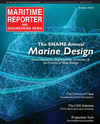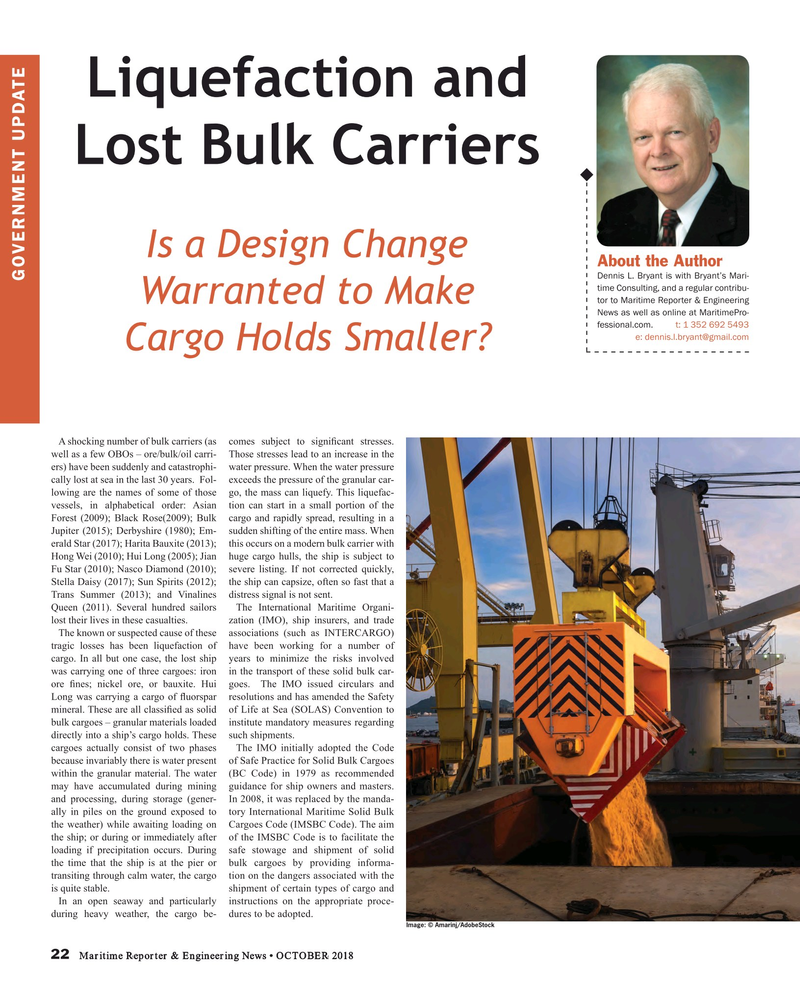
Page 22: of Maritime Reporter Magazine (October 2018)
Marine Design Annual
Read this page in Pdf, Flash or Html5 edition of October 2018 Maritime Reporter Magazine
Liquefaction and
Lost Bulk Carriers
Is a Design Change
About the Author
Dennis L. Bryant is with Bryant’s Mari-
GOVERNMENT UPDATE time Consulting, and a regular contribu- tor to Maritime Reporter & Engineering
Warranted to Make
News as well as online at MaritimePro- fessional.com. t: 1 352 692 5493 e: [email protected]
Cargo Holds Smaller?
A shocking number of bulk carriers (as comes subject to signi? cant stresses. well as a few OBOs – ore/bulk/oil carri- Those stresses lead to an increase in the ers) have been suddenly and catastrophi- water pressure. When the water pressure cally lost at sea in the last 30 years. Fol- exceeds the pressure of the granular car- lowing are the names of some of those go, the mass can liquefy. This liquefac- vessels, in alphabetical order: Asian tion can start in a small portion of the
Forest (2009); Black Rose(2009); Bulk cargo and rapidly spread, resulting in a
Jupiter (2015); Derbyshire (1980); Em- sudden shifting of the entire mass. When erald Star (2017); Harita Bauxite (2013); this occurs on a modern bulk carrier with
Hong Wei (2010); Hui Long (2005); Jian huge cargo hulls, the ship is subject to
Fu Star (2010); Nasco Diamond (2010); severe listing. If not corrected quickly,
Stella Daisy (2017); Sun Spirits (2012); the ship can capsize, often so fast that a
Trans Summer (2013); and Vinalines distress signal is not sent.
Queen (2011). Several hundred sailors The International Maritime Organi- lost their lives in these casualties. zation (IMO), ship insurers, and trade
The known or suspected cause of these associations (such as INTERCARGO) tragic losses has been liquefaction of have been working for a number of cargo. In all but one case, the lost ship years to minimize the risks involved was carrying one of three cargoes: iron in the transport of these solid bulk car- ore ? nes; nickel ore, or bauxite. Hui goes. The IMO issued circulars and
Long was carrying a cargo of ? uorspar resolutions and has amended the Safety mineral. These are all classi? ed as solid of Life at Sea (SOLAS) Convention to bulk cargoes – granular materials loaded institute mandatory measures regarding directly into a ship’s cargo holds. These such shipments. cargoes actually consist of two phases The IMO initially adopted the Code because invariably there is water present of Safe Practice for Solid Bulk Cargoes within the granular material. The water (BC Code) in 1979 as recommended may have accumulated during mining guidance for ship owners and masters. and processing, during storage (gener- In 2008, it was replaced by the manda- ally in piles on the ground exposed to tory International Maritime Solid Bulk the weather) while awaiting loading on Cargoes Code (IMSBC Code). The aim the ship; or during or immediately after of the IMSBC Code is to facilitate the loading if precipitation occurs. During safe stowage and shipment of solid the time that the ship is at the pier or bulk cargoes by providing informa- transiting through calm water, the cargo tion on the dangers associated with the is quite stable. shipment of certain types of cargo and
In an open seaway and particularly instructions on the appropriate proce- during heavy weather, the cargo be- dures to be adopted.
Image: © Amarinj/AdobeStock 22 Maritime Reporter & Engineering News • OCTOBER 2018
MR #10 (18-25).indd 22 MR #10 (18-25).indd 22 10/4/2018 9:05:45 AM10/4/2018 9:05:45 AM

 21
21

 23
23
